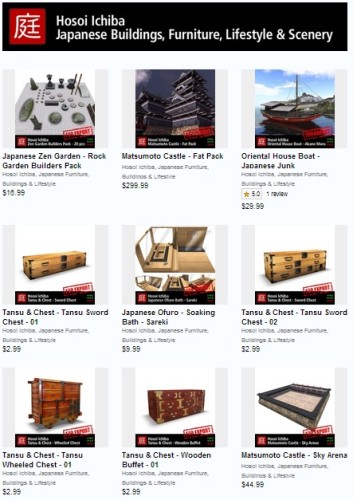Amiryu Hosoi has earned over $200 since starting to list items on Kitely Market last Tuesday. This is the story of how this well-known designer decided to try out this platform.
Hosoi started out in Second Life, with six regions on Japan Kanto, supported by her Hosoi Ichiba Second Life marketplace store.
“During my time in Second Life I specialized in Japanese architectural design, antiques and scenery,” she told Hypergrid Business. “Back then this was a niche market. Hosoi Ichiba supplied high quality goods and soon became a well known brand. Next to the Hosoi Ichiba marketplace I developed four scenery regions full of exiting stuff. The regions Japan Kanto, Japan, Kansai, Japan Chubu and China Sichuan all could be listed under the very best in Second Life. Our regions also became the home for a big community of Japanese minded people. We even had real Japanese people teaching about etiquette, art and lifestyle to other community members in our Hosoi Mura school and theater.”
These designs eventually migrated into the real world, and she launched My Oriental Garden, which designs, builds and sells luxury modern Japanese-style pavilions and buildings.
Hosoi first began looking at OpenSim when she needed a secure environment in which to create designs and save backups.
“I decided to export my complete My Oriental Garden inventory to my local OpenSim environment to work on,” she said.
OpenSim isn’t just about social grids that try to clone Second Life. It is server software that can also be run on a home computer or laptop. Users typically install the pre-configured Diva Distro version, the easier-to-use Sim-on-a-Stick, or New World Studio, which is so easy that you can have your own world up and running in just five mouse clicks.
A typical home computer can easily hold a mini-grid of one to four regions, which can then be backed up at will. Many content creators use private OpenSim mini-grids as warehouses and construction sites, accessible only by them and their employees. Private mini-grids can also be set up with hypergrid enabled, configured so that only members of a particular group can teleport to the grid or build there.
As part of her investigation of OpenSim, Hosoi also checked out several of the large public OpenSim grids. In February of 2012, she stopped by Kitely to look around.
Then, a year and a half later, she returned to check out the marketplace.

She was impressed, she said, by its functionality, its cost structure, and by the fact that Kitely CEO Ilan Tochner is out there talking to users.
“Ilan is a wonderful guy who is always trying to help,” she said. “I decided to rebuild my marketplace Hosoi Ichiba and the once famous regions in Kitely and here I am.”
Today, the Hosoi Ichiba Kitely Market store lists 111 items, about a fifth of the inventory of the Second Life store.
“This is a lot of work because I need to review, export, import, relist, update all my products,” she said. “The hard work however is mostly on the Second Life side. The people who designed the Kitely Market really understand what a merchant needs. Clear design, intuitive interface, wonderful variations feature, you name it and it is there. Working with the Kitely Market as a merchant is a breeze.”
Dealing with the hypergrid
The Kitely grid is currently not hypergrid enabled, and residents of other grids can’t shop on the Kitely Market. But both of these are going to change in the next few months.
Some content creators worry that exposing their content in OpenSim means that people will copy it and distribute it for free without the creator’s permission.
Today, Kitely content is locked down. The creator sets the permissions, and the only way content can leave the grid is via OAR file region exports, and those are filtered so that only permitted content is exported.
Hypergrid connectivity, and hypergrid distribution of content, “will shake the virtual worlds on their foundations,” Hosoi said.
She herself had fears of losing content.
But since then, she’s changed her mind, and is now one of the creators actively embracing the hypergrid.
“People who want free stuff will take it anyway, no matter if you lock it,” she said.
She pointed to iTunes as an example of an online marketplace that distributes digital content with no built-in copying restrictions. After all, DRM-free, easy-to-copy music is already widely available for free, on the Internet.
Marketplaces such as iTunes and Amazon and services like Netflix, by providing an affordable, convenient and legal alternative, have created successful and profitable online distribution channels for movies and music. Meanwhile, neither legal nor technical efforts have been successful in curbing piracy.
The same principle holds in virtual worlds, Hosoi said. “Making it easier for everyone to legally buy your goods via hypergrid to use them wherever they want will make people think twice — why go through all the hassle stealing content when you can buy what you want and use it legally anywhere, on any grid?”
Kitely Market already supports export permissions, allowing content creators to choose whether their creations will, someday soon, be available for purchase to residents of other grids.
There are around 9,000 active users on the hypergrid-enabled public OpenSim grids, but many of them are educational institutions and businesses with larger budgets than casual users, and a need for legitimate, properly licensed, high-quality content.
“The fact that content providers will be able to deliver goods to all other hypergrid connected grids out there gives us the possibility to really expand beyond the closed box that is known as Second Life,” said Hosoi.

Hosoi lists her products in two variations — one for local, Kitely use only, and another, higher-priced one, with export rights.
“This doesn’t mean people are free to give away or sell my products to anyone else,” she wrote in a recent post on her blog. “Please play a fair game.”
So far, this strategy is paying off, with $200 in sales since her store opened last Tuesday.
“I would strongly advise all serious content providers and merchants out there in Second Life to jump on the train,” she said.
She said she is putting the money towards setting up and maintaining unlimited-access regions on Kitely. “Those regions will be free for everyone to enjoy,” she said.
(Do you have a story to tell about a successful OpenSim commerce experience? Drop me a line at maria@hypergridbusiness.com!)
- OSgrid wiping its database on March 21: You have five weeks to save your stuff - February 15, 2025
- OpenSim activity up with the new year - January 15, 2025
- OpenSim land area, active users up for the holidays - December 15, 2024
